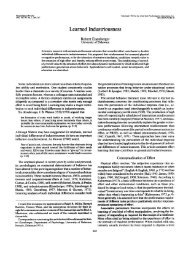Perceived Organizational Support
Perceived Organizational Support
Perceived Organizational Support
You also want an ePaper? Increase the reach of your titles
YUMPU automatically turns print PDFs into web optimized ePapers that Google loves.
Coyle-ch10.qxd 1/16/04 3:00 PM Page 222<br />
222 Exchange Nature of Employment Relationship<br />
organization. Further progress in this line of research, we believe, will depend greatly<br />
on the theory’s elaboration and evolution to explain a greater diversity of employee<br />
behavior. In the preceding, we detailed OST and indicated possible bases for its<br />
integration with other recent social exchange accounts. As additional directions for<br />
theoretical development we suggested a consideration of relationships between POS<br />
and employee socialization, employee attributions of positive valuation by the<br />
organization, contingent employment relationships, and strategic human resources<br />
management. These are but a few of the new directions we hope researchers will<br />
explore in extending organizational support theory.<br />
References<br />
Allen, D. G., Shore, L. M., and Griffeth, R. W. (2003). “The role of perceived organizational<br />
support and supportive human resources practices in the turnover process.” Journal of<br />
Management, 29: 99–118.<br />
Armeli, S., Eisenberger, R., Fasolo, P., and Lynch, P. (1998). “<strong>Perceived</strong> organizational support<br />
and police performance: The moderating influence of socio-emotional needs.” Journal of<br />
Applied Psychology, 83: 288–97.<br />
Aselage, J., and Eisenberger, R. (2003). “<strong>Perceived</strong> organizational support and psychological<br />
contracts: A theoretical integration.” Journal of <strong>Organizational</strong> Behavior, 24: 491–509.<br />
Ashford, S. J., and Cummings, L. L. (1983). “Feedback as an individual resource: Personal<br />
strategies of creating information.” <strong>Organizational</strong> Behavior and Human Performance, 32:<br />
370–98.<br />
Bies, R. J., and Moag, J. S. (1986). “Interactional justice: Communication criteria of fairness.”<br />
Research on Negotiation in Organizations, 1: 43–55.<br />
Cable, D. M., Aiman-Smith, L., and Edwards, J. R. (2000). “The sources and accuracy of job<br />
applicants’ beliefs about organizational culture.” Academy of Management Journal, 43:<br />
1076–85.<br />
Cobb, A. T., and Wooten, K. (1998). “The role social accounts can play in a justice intervention.”<br />
In W. Pasmore and R. Woodman (eds.), Research in <strong>Organizational</strong> Change and<br />
Development, Greenwich, CT: JAI Press, 73–115.<br />
Coyle-Shapiro, J. A. M. (2001). “Managers: Caught in the middle of a psychological contract<br />
muddle.” Paper presented at the Annual Meeting of the Academy of Management,<br />
Denver.<br />
—— and Kessler, I. (2000). “Consequences of the psychological contract for the employment<br />
relationship: A large scale survey.” Journal of Management Studies, 37: 903–30.<br />
—— and —— (2002). “Exploring reciprocity through the lens of the psychological contract:<br />
Employee and employer perspectives.” European Journal of Work and <strong>Organizational</strong><br />
Psychology, 11: 69–86.<br />
Cropanzano, R., Howes, J. C., Grandey, A. A., and Toth, P. (1997). “The relationship of<br />
organizational politics and support to work behaviors, attitudes, and stress.” Journal of<br />
<strong>Organizational</strong> Behavior, 22: 159–80.<br />
Delery, J. E., and Doty, D. H. (1996). “Modes of theorizing in strategic human resource<br />
management: Tests of universalistic, contingency, and configurational performance predictions.”<br />
Academy of Management Journal, 39: 802–35.



